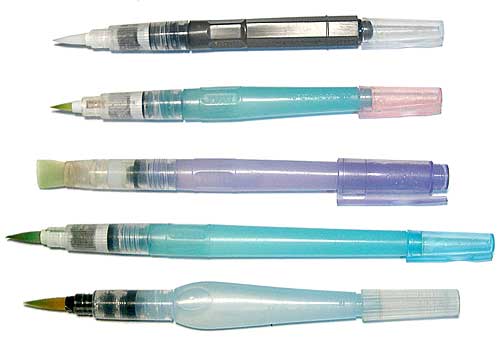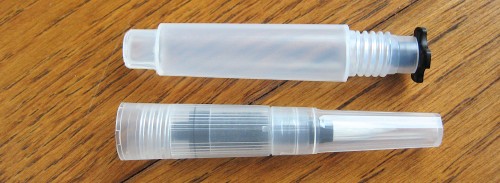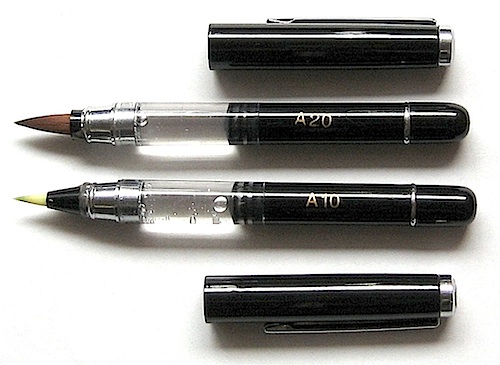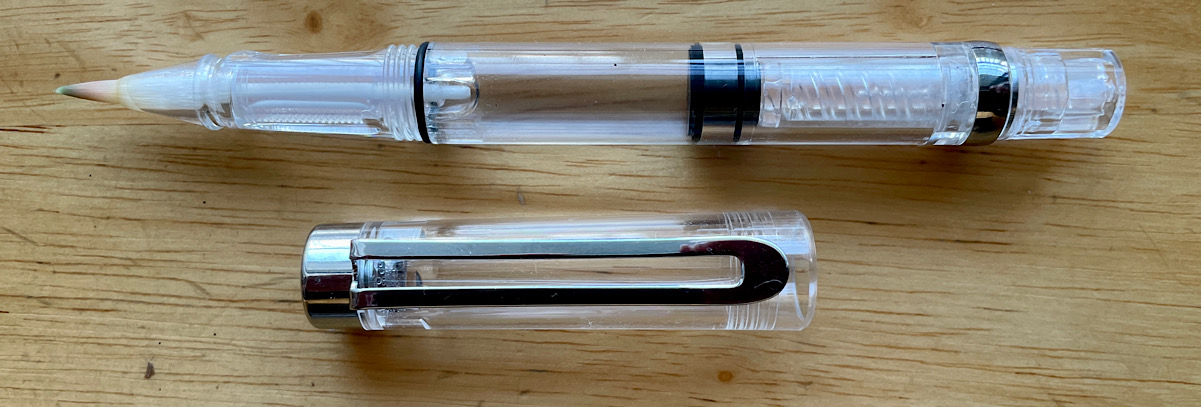
|

|
 |
My observations on the Waterbrush For those who don't know, a water brush or waterbrush (some makers use two words while others combine them into one) has a soft plastic barrel which contains water. When you squeeze the barrel, water enters the bristles, thus eliminating the need for a separate water container. It also makes cleaning the brush between colors a breeze. These are great for watercolor sketching on location. All you need is a waterbrush, a small set of half pan watercolors and a sketchbook, plus some tissue paper or a rag. No more water bottle and cup. If you use a small sketchbook, your entire set up will fit in a pocket. Waterbrushes started appearing in Japan in the 1990s and have recently become very popular around the world. In Tokyo, I've noticed there are more books on sketching which recommend the waterbrush now, including several books by Chihiro Tanaka, the man who is credited with inventing these. He used to empty the ink out of regular brush pens and fill them with water. Then he included photos of these modified tools in his books on watercolor sketching. Some of brush pen makers realized he was on to something big and started to produce these brush pens with translucent barrels and no ink, calling them waterbrushes (mizu-fude -- pronounced mee-zoo-foo-deh). One of Mr. Tanaka's latest books on sketching with the waterbrush is in my recommended book list (see the link at the bottom of this page).  I have been using either Pentel Aquash (the one at bottom of the photo) or Kuretake (pronounced koo-reh-tah-keh) Phys waterbrushes (the three in the middle) almost to the exclusion of my regular brushes. There's a web site dedicated to the Kuretake Phys waterbrush. It's written by Chihiro Tanaka (mentioned above) and is mostly in Japanese, but there is a small English section there, too. When you first start using a waterbrush you may find it more difficult to use than a regular brush because you have to take into account the constant water supply coming down through the bristles. With a little practice these do become easy to control. You can even get dry brush effects. One cool thing about waterbrushes is that the constant water supply will allow you to go from dark to light in a natural unbroken graduation. You can start your stroke where you want the color to be the darkest and most saturated, and work your way to the lighter, less saturated areas. If you stay with the stroke long enough, it will go all the way to pure water. You can utilize this unique feature to get some great effects. Of course most of the time you do not want the water to paint ratio changing with every stroke. It may not be an issue when painting small areas, but it is very noticeable on larges areas such as skies. So this feature is both an asset and a liability, and one reason I hold on to my old regular brushes. I hope someday someone will invent a waterbrush with a water shut-off system so we can have the best of both worlds. I have read on other web sites that a lot of people prefer the water flow and bristles of the Pentel Aquash water brush over the Kuretake in its various manifestations (more on these below). I personally prefer the water flow on the Kuretake over the Pentel. You can send water through the bristles with less effort on a Kuretake waterbrush, which is helpful when you are washing the brush. While on a Pentel you really have to squeeze to get a trickle, you can send a stream of water out of a Kuretake with much less effort. Also, the flow is better controlled on the Kuretake so water won't drip on your work unexpectedly -- like one of my Pentels did. Maybe one reason many people prefer the Pentel is that that the more restricted water flow helps keep the water to paint ratio more consistent. Pentel bristles always come back to a sharp point and are more firm than Kuretake. So when you want fine detail and crisp lines, the Pentel is better. The Kuretake bristles are softer and more floppy than Pentel, and don't come to a sharp point. These are good in situations where you would normally use a floppy round brush. I did a Frankenstein job on a few of my small size Kuretake waterbrushes, and put Pentel bristles in them. Now I can get crisp fine lines with great flow. Since both waterbrushes have their place, I would recommend you buy one of each. You may find you need both to get the job done. By the way, all my waterbrushes seem do just as good a job at holding and moving paint as my traditional brushes. I must qualify that by saying that most of my traditional brushes are second rate sables or synthetics. No doubt the more expensive sable brushes can hold a lot more paint than these. While waterbrushes are great for sketches and small paintings, large scale paintings would be beyond their limitations. Like many synthetics, the nylon bristles on the waterbrush do stain with certain colors, such as Thalo green, (as the photo shows) but it doesn't affect the painting. Apparently you can't buy the Kuretake Phys waterbrush outside of Japan, but recently I bought a Staedtler Water Brush (top of photo) and discovered it was identical to the Kuretake Phys Waterbrush except for the color and contours of the barrel design. The inner parts were identical, and the screw-together sections were even interchangeable. This leads me to believe that other waterbrushes that resemble the Kuretake Phys waterbrush such as the Niji waterbrush, ROYMAC Waterscape Brush and ZIG Brush H2O are actually produced from the same specs. I think the ZIG is actually made by Kuretake since ZIG is a name for other Kuretake products.   This has got to be the most portable waterbrush out there. It's the Sakura Koi Waterbrush and it comes in two separate pieces that screw together, the longer piece being 7.1 centimeters long (2 13/16 inches). The barrel holds water and has a small cap. Don't lose it! I want to say the proper pronunciation of Sakura is sah-koo-rah with the accent on the first syllable, but in their own American demos they call it suh-koo-ruh with the accent on the second syllable; apparently they figured it's a problem not worth correcting. I had planned to put a few links to waterbrush vendors here, but I discovered that there are so many vendors and new brands of waterbrushes that it would be impossible to select just a few. Here are the names of the waterbrush brands I've found so you can copy and paste and do a web search for them yourself:
Niji waterbrush
The waterbrush will never render traditional watercolor brushes obsolete, but I think it will eventually become the preferred tool for the majority of watercolor sketch artists, especially those who are just beginning to sketch and paint. And keep in mind, the waterbrushes of today may be considered merely the first generation; improvements may come which could seduce even the die-hard purist. Update (August 2006): It has been over two years since I wrote the above article. During that time I have gone back and forth between waterbrushes and regular brushes, and it looks like the waterbrushes have won. Water is always the biggest issue when sketching on location, and carrying a water supply is the biggest burden in terms of luggage space and weight. A waterbrush requires less water to clean since it is more efficient to channel a small amount of water through the brush than to swirl the brush in a cup of water, dirtying all the water. It is still difficult to paint large expanses with a waterbrush, but the makers of the Kuretake Phys (Niji) type have tried to address that issue with the flat version (It's the purple one in the middle of the top photo). This brush does help, especially with painting skies, but is still limited by its size, about 1 centimeter (3/8 of an inch) wide. Pentel Aquash waterbrushes can now be found in most stationery stores, or stationery departments in larger stores in Tokyo while the Kuretake Phys waterbrushes are mostly limited to art supply stores. I prefer Kuretake Phys waterbrushes. Other artists have told me they prefer the Pentel Aquash, so it is still a matter of personal preference. Although I have highlighted the differences between these brands, they are really small. It might just depend on which type you have gotten accustomed to. My own sketching/painting style has changed to accommodate my waterbrushes. Now I put more gradation in the washes by utilizing the change in water to paint ratio. If you have paint only on the tip of the bristles and let more of the surface of the side of the brush touch the paper, you can get some nice gradation effects in a single stroke. Many watercolor artists teach that you should avoid large boring expanses of the exact same color and tone but instead put lots of variety in the washes so that no square inch exactly resembles another. Of course there are other artists who teach the opposite, as one can expect in any subject related to art. If you do watercolor sketches on location and don't work any bigger than 9 x 12 inches (or F3 size) than you ought to give the waterbrush a try. It could make life easier for you and even change your style. Update (October 2011): There is a new type of waterbrush on the market now by Blue Heron Arts that uses a piston filling mechanism. It comes in both a long model for painting at home and a portable pocket version (in the photo below) which has me excited because it is so portable and looks good in the pocket as well. The bristles look and feel the same as soft traditional brushes, so you can use many of the same techniques you could do with a regular brush which are not so easy with stiff white bristles on the squeeze type waterbrushes mentioned above. The piston also gives you better control over the water flow, even to the point of stopping the flow completely for dry techniques, and you can turn it with one hand alone by grasping the end knob with your little and ring finger and rotating the barrel with your thumb and index finger. You can also post the cap and turn it, which will then turn the knob, but I prefer to use it with no cap posted because it seems better balanced and easier to handle that way. One draw back is that the piston takes up so much room, this pocket version will run out of water before you can finish an average size sketch. But it is perfect for postcard size sketches as well as trading card size sketches (ATC and ACEO). Of course, you can also take a few waterbrushes with you to make sure you don't run out of water. Although you can turn the piston with one hand, you should use two hands to uncap the water brush barrel. I usually uncap my fountain pens with one hand, but if you try that with these brush pens, it can snap the pen in two. I know because I did it! These waterbrushes come in two tip sizes, the larger one (model number A20 I took this photo after I had used the brushes daily for a few weeks.  The one problem I have encountered with these is the fact that water can come out the sides of the black plastic section that holds the bristles. There is a some kind of air vent on the larger of the two, and two vents on the smaller one. They don't seem necessary, and caused water to come out the sides when I wanted it to come out the tip. After I plugged them up, the flow was much more predictable, and these brushes do exactly what I want, and work like a dream. I used J-B weld since it was handy -- it's dark gray and barely visible in the photo (every handyman should have a few tubes of J-B Weld sitting in a drawer somewhere). The maker says to fill these by pointing the pen downward and submerging the tip in a glass of water, but I'm lazy, so I just hold them upright under a faucet with running water and turn the piston knob to fill up the barrel. That works well for both piston and squeeze type waterbrushes. Update (November 2022): I discovered a Chinese piston brush pen on many web sites including Amazon and eBay. These are a bit larger than the Blue Heron Arts water brush, and can be taken apart. I saw their potential as water brushes although they are not advertised as water brushes. Since they were inexpensive, I ordered some from both web sites, and they turned out to be perfect for subway sketching. If you click on the image it will take you to a larger one. 
|
Here are Amazon links to products mentioned on this page:
|
|